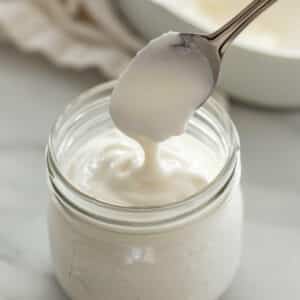Learn how to store fresh turmeric root easily that keeps well. Store in the fridge for two weeks, or in your freezer for up to six months. It's more than likely that you've already heard about this knobbly, orange rootlike spice that people use with lattes, milk, Indian curry, and even tea. But were you aware that it also boasts significant health properties?
Here, in this article, I will explain why fresh turmeric is good for your health, how you can cook with it, and how it ought to be stored.
Jump to:
It's not exactly the prettiest of the fresh herbs and spices, as when it is dug up out of the soil, it is quite ugly. However, appearances can be deceptive. Good-looking it certainly isn't, but its taste and health benefits are appreciated the world over.
If you'd like to know more about what this spice can do for your health; or how to get the best out of it in your recipes, please read on.
Why is fresh turmeric good for you?
Turmeric root, once it is cleaned and skinned, is bright orange. Although it is often commonly referred to as being a root, technically, it is a Rhizome - a stem that grows underground.
Because it is a stem and not a root, it has nodes that enable it to put out other stems. It is highly regarded for its antibacterial, anti-inflammatory, and antioxidant characteristics.
Turmeric is used extensively in Ayurvedic and Chinese natural medicine. It has been documented going back centuries as being used to treat skin wounds and conditions, combat inflammation, and fight infections.
It is also referred to as Haldi, Haridra, Jiang Huang, and Indian Saffron in powdered form as it gives the foods to which it is added a distinctive yellow color.
Curcumin is turmeric's prime active ingredient. It is a substance that has been proven to reduce the occurrence of particular types of cancers in countries where residents consume it as part of their routine diets.
Dried turmeric is the result of removing the Rhizome's skin, boiling, and drying, then finally grinding it into powder form. Fresh and ground turmeric are different from each other as chalk and cheese because the powdered version loses much of its special oils.
However, it does retain its color, and it adds an earthy warmness to the dishes to which it is added.
A great read about turmeric:
- An overview study of curcumin and its effects
- Role of curcumin in disease prevention & treatment
- 10 benefits of turmeric
Difference between fresh and dried turmeric?
As far as cooking with turmeric goes, there are two or three options. You can use it fresh, whole dried, or ground.
My preferences are to use it fresh when sauteing or making smoothies and ground when roasting veggies or making rice pilaf as it gives it great color. Here's the quick guide to fresh and dried turmeric.
Fresh turmeric
Fresh turmeric looks a bit like fresh ginger root - in fact, it is a member of the same family. As with ginger, fresh turmeric's flavor is more vibrant than when it is dried.
The Rhizome's flesh is a lively orange color, and it has a slightly acrid, earthy, peppery flavor with a hint of bitterness.
When fresh turmeric is more mature, the skin tends to be thicker and needs scraping off before using the flesh.
As with fresh ginger root, you can cut fresh turmeric in several ways; into coin-shaped slices, fine matchsticks, or cubes. You can also grate it using a Microplane or cheese grater.
You can expect to find it in the fresh herbs and spice section of your local grocery store. You can also come across it in Asian and Indian stores and some health outlets.
When sorting through fresh turmeric rhizomes, avoid anything that feels soft, dried, or shriveled, and pick the firmer ones. When you get it home, store it in an airtight container or ziplock bag in your fridge where it will keep nicely for up to two weeks. If you want to store it for longer, you can put it in your freezer for a few months.
Dried turmeric
You dry turmeric by peeling or scraping the skin off, boiling the rhizomes, then drying them and keeping the pieces whole, or grinding them down into a fine powder.
Ground turmeric loses some of its oils and is less potent. But in its ground form, it is perfect for adding to casseroles, stews, and of course, curries.
I find you get the most out of its unique flavor when you slice or grate it from fresh.
A good tip to help you find the freshest turmeric is to shop in ethnic grocers or stores specializing in selling whole, fresh herbs, and spices.
Colorwise, fresh turmeric can be anywhere from dark yellow to bright orange. I find the best indicator of freshness is its pungent aroma - the more intense, the better.
Whole dried rhizomes will keep up to one year when stored in a dark, cool cupboard, inside an airtight container.
How to peel fresh turmeric?
Once you have peeled your fresh turmeric, it can be grated or sliced, but what is the best way of peeling it?
The ease of peeling depends on the freshness. The older it is, the more difficult it becomes to peel, but it's never that difficult.
One way that always works is to use a veggie peeler or a paring knife. But if it is really fresh, the peel can be removed by rubbing the rhizomes with a spoon's back.
Having removed the skin, its earthy, orangey flesh is ready to use. I like it finely grated. Because it is not a fibrous as ginger, it grates beautifully.
A word to the wise.
The vibrant color of turmeric is, in fact, a natural dye, and it will stain both your hands and any working surfaces. It's best to wear kitchen gloves when you peel it and when you set it down, put it on disposable kitchen paper or a non-stain surface.
If you do stain your hands, try using lemon juice to help remove it.
Equivalents
Depending on the thickness or diameter of the Rhizome, one inch of fresh turmeric will give you between 1 teaspoon and one tablespoon of grated turmeric.
How long does fresh turmeric root last in the fridge?
If it is still intact with its skin, you can store fresh turmeric in your fridge for anywhere up to two weeks.
However, it is best to make sure it is as dry as possible, so if the rhizomes are wet or damp, dry them with a sheet of paper kitchen towel and put them into a plastic ziplock bag.
Look at it from time to when stored in the fridge to check for any mold development spots. If you do spot any, you can cut them out and keep the remainder. Two weeks is the maximum storage time, after which you should throw it away.
If you intend to keep it longer, you can slice it, wrap it, and store it in your freezer for many months. Frozen turmeric will lose some of its firm texture, but if used in recipes that call for it to be minced or mashed - no problem.
How to store turmeric root
Like any raw produce, fresh turmeric is perishable with a short shelf life in the fridge. You can store the roots in two ways: store them in the refrigerator or store them in the freezer.
Step 1
Before you store fresh turmeric, you need to get rid of any dirt with a small brush. Wherever it came from - your local grocery store or your own indoor garden, cleaning before storing is essential.
You can use your fingers to get rid of any earth that may be stuck to it or give it a vigorous scrub with a vegetable brush. The rhizomes can be quite gnarly, so make sure to clean them thoroughly.
Step 2
Dab dry with a piece of paper kitchen towel. The most common problem with storing turmeric root in your fridge is that mold can develop. Drying it properly helps to stop this from happening.
Step 3
To help keep it dry and soak up any condensation that could form on it when stored inside a fridge, I like to wrap the rhizomes in a dry paper kitchen towel and then place them into a ziplock bag.
Don't wrap them too tightly, though. Give them a chance to breathe. Before you put the bag into the fridge, squeeze out as much air as possible before sealing.
Another idea is to wrap the turmeric in a paper bag if you don't have any kitchen towel to hand. This, too, will absorb any moisture that might form.
Step 4
Find an area inside your fridge where you can easily see the bagged turmeric, or it could be a case of, out of sight, out of mind. You don't want to store for any longer than about two weeks.
As I mentioned earlier, if you do spot any mold spots, cut them out and restore the rest of the Rhizome in a new piece of paper kitchen towel, as the old piece could be contaminated with spores.
How do I prepare fresh turmeric?
Part of my routine is to enjoy a morning cup of warm milk with powdered turmeric. In the beginning, I used store-bought products, but when we found out that some brands of powdered turmeric contain artificial colorants, we changed tack.
I was drinking it for its health benefits, so the last thing I wanted to do was ingest chemicals.
So, I decided to change from powdered turmeric to fresh, grated.
However, I found that the grater turned yellow each time, and it was an annoying chore to clean it every day. So, I did some research and came up with the idea of using frozen turmeric instead.
Now I can enjoy my turmeric-infused milk-drink every morning without all of the hassles of daily cleaning the grater.
All it takes is to pop the milk with frozen turmeric into the microwave for a minute or so, and its job is done.
I prepare in bulk, so instead of that horrible, nasty daily cleaning grind, I only have to do it once every few weeks or months, depending on how big a batch I freeze.
You can also use turmeric to make a Turmeric Carom Latte, an excellent remedy for coughs and colds.
How do you freeze fresh turmeric root?
Step 1
Wash the Rhizome, peel away the skin, and cut into small pieces.
Step 2
Take your food processor and rub the inside of the bowl with two or three drops of oil. This helps to make cleaning the bowl easier when you're finished. Add the pieces of turmeric and blend into a smooth paste.
Step 3
-
- Take a flat plate, cover it with plastic film-wrap, and spread a thin layer of the turmeric paste over the film.
- Place in the freezer for three or four hours.
- Once it's frozen solid, you can peel away the plastic film (it comes out very easily), then either break the frozen turmeric paste into small pieces or, if you prefer, you can cut it into pieces with a knife.
As you only spread the paste thinly, you'll find that it breaks easily. Put the broken pieces into a ziplock bag and store them back in the freezer.
Step 4
Each morning, I add a small piece of frozen turmeric into the milk and pop it into the microwave for a few seconds. Add as little or as much to the milk as you like, but don't go overboard as it can be a little bitter if you do. Crack some ground black pepper for an extra anti-inflammatory effect. It's so easy, and what's best - no big cleaning job every morning.
Using an Ice-Cube Tray
Step 1
-
-
- Prepare your paste in the food processor.
- Take your fridge ice-cube tray.
- Line with plastic film before filling the hole with paste, leaving a good overhang on each side. The film will help to protect the tray from getting stained.
-
Step 2
Spoon one to two teaspoons of turmeric paste into each recess.
Step 3
With some kitchen scissors, cut the excess film to be able to seal the turmeric packet.
Step 4
Once all wrapped, put into a freezer-friendly Ziplock bag and freeze.
Now, every time you fancy a cup of golden turmeric-infused milk, all you have to do is take one or two pieces of turmeric out of your freezer, and you're away.
Ways to remove turmeric stains without ruining your utensils
Don't forget to clean your kitchen utensils as quickly as you can once you've finished with them. The longer you leave turmeric stains in place, the harder it is to get rid of them.
#1 Dishes - Two Ways
I will go over two cleaning methods for dishes: glass, glazed ceramic, or plastic. Don't use lunch containers. If you do, you'll never get clean the stains away completely.
Method one: Using bleach
Step 1
Take the stained dish and immerse it in a 2:1 solution of hot water and bleach. This equates to a proportion of two-thirds of a mug of hot water to one-third of a mug of bleach.
If you are concerned about using bleach, try pure white vinegar instead (see method #2 below).
Step 2
Leave the dish immersed in the solution to soak overnight.
Step 3
Next morning, discard the solution and wash the dish with warm, soapy water. You can also use this same method to get rid of any stains on your blender, food processor, or juicer.
Method Two: Lemon juice or white vinegar
Acidic liquids like lime juice or white vinegar can also be used to get rid of turmeric stains. This is better than using bleach if your cleaning utensils have a natural color you wish to retain.
- The proportion of your solution should be two cups of hot water for every one cup of lime juice or white vinegar.
- As with the bleach option, leave the utensil to soak in the solution overnight.
The acidic solution's action will soak the stains away, leaving you with a clean dish in the morning. You can also use this type of solution to help you eliminate any stains on your fingernails or hands. Just rub the solution gently, and rinse with warm water.
You can also use the clothing stain remover, OxiClean. Mix with water, immerse the utensil into it, and soak for 30 minutes; remove and rinse clean with warm, soapy water.
#2 Countertops - Five Ways
The methods we are about to discuss are perfectly safe on natural stone working-surfaces. However, they are a little abrasive, so take care not to overdo it. To help you err on the safe side, please click here. You don't want to ruin an expensive kitchen countertop.
Option #1: Baking Soda Paste
Step 1
Make up a 1:1 paste using 1-part baking soda and 1-part water.
Step 2
Apply it to the work-tops stained area and allow it to work for 15 minutes before you scrub it off.
Step 3
If you need a little more scrubbing power, you can rub in some lemon juice or white vinegar.
Option #2: Magic Eraser
Using something like Mr. Clean Magic Eraser, scrub the area until all of the stains have gone; Please srub gently. Products like this have a similar action similar to that of fine sandpaper. Scrub with too much force, and you could remove the countertop's protective gloss.
Option #3: Bar Keeper's Friend
Another product recommended for this sort of work is Bar Keeper's Friend. It is a powder. To apply, sprinkle it onto a damp cloth and work into the area.
Option #4: Oxiclean
Oxiclean is a stain remover designed to remove stains from clothes. However, you can also use it to remove tough stains from your dishes.
Step 1
Mix the Oxiclean powder with water to create a paste. As with the baking soda process, apply it to the area and allow it to sit for about a quarter of an hour.
Step 2
Wash down with warm, soapy water.
Option #5: Hydrogen Peroxide
You may know Hydrogen peroxide is a mild antiseptic that can be used on the skin to prevent any infection to burns, minor cuts, and scrapes.
However, this light blue liquid also is purposed to remove turmeric stains.
All you need are a few drops. Another substance you can try is chlorinated bleach.
#3 Linens
Turmeric stains on linens can be challenging to remove.
However, it can be done, and here's how:
Step 1
When it is an oil-based stain - like split curry, for example, the first thing to do is wipe off as much as you can. A knife is handy for this as you can get the blade under the spillage and lift it away without pressing it into the fabric.
Step 2
Take a pinch of baking soda, corn-starch, or flour between your fingers and sprinkle onto the stain. Leave for 20 minutes for it to draw the oil out of the linen.
Step 3
Immerse linen's stained area into a bowl of white vinegar and leave for 60 minutes. You can use apple cider vinegar, but you need to be aware that it will leave a yellowish stain.
Step 4
Remove the linen from the soak and wring out any excess liquid. If you can still see a remnant of the stain, rub some whitening toothpaste (non-gel type) into the area. Continue rubbing and adding more as necessary until the sain has completely disappeared.
Step 5
Rinse with clean water, wring out and allow to dry.
Instead of flour and vinegar, another option is a good laundry detergent with water. Use the same procedure and repeat as necessary.
If all else fails, you can use bleach and hot water, as long as the linen is not colored.
What can I do with fresh turmeric?
Turmeric is very versatile. Here are four recipes to try out.
Option 1 - A nice cup of the hot golden milk
- Put one pinch of turmeric (skinned and grated) into a small pan with 300ml of whatever type of milk you prefer - almond, cows, oat, etc.
- Heat until about to boil - but don't let it.
- Strain through a fine sieve and sweeten with a little honey and ground black pepper to enhance the anti-inflammatory effect.
Option 2 - Have a caffeine-free pick-me-up with turmeric tea
Turmeric tea also is drunk to help to speed up recovery from a cold.
- Add one inch of skinned, grated turmeric into a cup of the fresh juice squeezed from a quarter of a lemon.
- Sprinkle in a touch of ground black pepper. Black pepper contains Piperine, a substance that assists with curcumin absorption - turmeric's main active ingredient.
- Add 300ml of hot water. To give it a little more zip, you can also add a smidgin (about half an inch) of grated or sliced fresh ginger root.
Option 3 - Blend into a Smoothie
Instead of ginger, or in addition to, why not add a little turmeric? If you want to promote an orange appearance to your smoothie, add some carrots and oranges, or mix things up a little by adding to your green morning smoothie.
Option 4. Add a punch to your eggs!
Last but not least, you can add turmeric to eggs. It gives them a tremendous little flavorsome twist.
- It can be grated and added to your egg recipe repertoire to make frittatas, omelets, and scrambled eggs.
- You can also add a little finely grated turmeric to a pastry (samosas or pies) egg wash for a delicious gold-colored shine.
Other interesting posts:
- Can you Freeze Ranch Dressing?
- How Long Does Cool Whip Last in the Fridge
- How Long is Cooked Pasta Good For
Storing turmeric root (How to)
Pin RecipeIngredients:
- Turmeric root
Instructions:
Storing in the Fridge:
- Before you store fresh turmeric, you need to get rid of any dirt with a small brush. Wherever it came from – your local grocery store or your own indoor garden, cleaning before storing is essential.
- Dab dry with a piece of paper kitchen towel. The most common problem with storing turmeric root in your fridge is that mold can develop. Drying it properly helps to stop this from happening.
- To help keep it dry and soak up any condensation that could form on it when stored inside a fridge, I like to wrap the rhizomes in a dry paper kitchen towel and then place them into a ziplock bag.Don’t wrap them too tightly, though. Give them a chance to breathe. Before you put the bag into the fridge, squeeze out as much air as possible before sealing.Another idea is to wrap the turmeric in a paper bag if you don’t have any kitchen towel to hand. This, too, will absorb any moisture that might form.
- Find an area inside your fridge where you can easily see the bagged turmeric, or it could be a case of, out of sight, out of mind. You don’t want to store for any longer than about two weeks.As I mentioned earlier, if you do spot any mold spots, cut them out and restore the rest of the Rhizome in a new piece of paper kitchen towel, as the old piece could be contaminated with spores.
Store in the Freezer:
- Wash the Rhizome, peel away the skin, and cut into small pieces.
- Take your food processor and rub the inside of the bowl with two or three drops of oil. This helps to make cleaning the bowl easier when you’re finished. Add the pieces of turmeric and blend into a smooth paste.
- Take a flat plate, cover it with plastic film-wrap, and spread a thin layer of the turmeric paste over the film. Place in the freezer for three or four hours. Once it’s frozen solid, you can peel away the plastic film (it comes out very easily), then either break the frozen turmeric paste into small pieces or, if you prefer, you can cut it into pieces with a knife.As you only spread the paste thinly, you’ll find that it breaks easily. Put the broken pieces into a ziplock bag and store them back in the freezer.
- Add a small piece of frozen turmeric into the milk and pop it into the microwave for a few seconds. Add as little or as much to the milk as you like, but don’t go overboard as it can be a little bitter if you do. It’s so easy, and what’s best – no big cleaning job every morning.
Freezing using Ice cube tray:
- Prepare your paste in the food processor. Take your fridge ice-cube tray. Line with plastic film before filling the hole with paste, leaving a good overhang on each side. The film will help to protect the tray from getting stained.
- Spoon one to two teaspoons of turmeric paste into each recess.With some kitchen scissors, cut the excess film to be able to seal the turmeric packet.
- Once all wrapped, put into a freezer-friendly Ziplock bag and freeze. Now, every time you fancy a cup of golden turmeric-infused milk, all you have to do is take one or two pieces of turmeric out of your freezer, and you’re away.
Please note that all nutrition information are just estimates. Values will vary among brands, so we encourage you to calculate these on your own for most accurate results.









